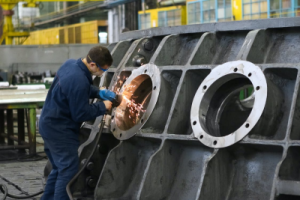Starting a new business is an exciting venture, but it can also be intimidating. One of the most important decisions you will make is designing the manufacturing facility for your product or service. This process requires careful planning and research to ensure that you have all the necessary resources to create a safe and efficient production line. With the right approach, you can design a manufacturing facility that meets your needs and sets up your business for success. In this article, we’ll discuss how to go about designing a manufacturing facility for your new business. We’ll cover topics such as determining space requirements, selecting equipment, ensuring safety measures are in place, and more.
1. Determine Your Space Requirements
The first step in designing a manufacturing facility is to determine the amount of space needed for production. Before choosing a location, consider factors such as the size and type of equipment needed, how many employees you need to hire, and what type of products or services you plan to offer. Once these are known, you can start looking for a suitable warehouse or building that fits your needs. However, if you are interested in purchasing a garage kit then if you visit quonsetkits.com, you can get an idea of how to get one and how much it would cost. Also, consider the layout of the space, making sure to factor in any necessary storage areas, employee break rooms, and production lines.
2. Select Equipment
Once you’ve chosen a suitable location for your manufacturing facility, it’s time to select the equipment needed to produce your product or service. Depending on what type of products or services you are offering, different machinery may be required. Consider factors such as cost, efficiency, safety protocols, and energy requirements when selecting equipment for your facility. If you are unsure about which pieces of equipment would best suit your needs, consulting with an experienced professional can help ensure that you make the right choices. In addition, you may want to consider investing in automation or robotics that can help streamline production and reduce costs.
3. Ensure Safety Measures Are In Place
Safety should always be a top priority when designing a manufacturing facility, as it is essential for protecting employees and customers alike. Make sure to research the safety standards needed for your industry and ensure that they are met before production begins. This includes anything from wearing protective gear to ensuring proper ventilation systems are in place. Additionally, fire safety protocols should also be established in case of an emergency situation. Finally, provide adequate training for all staff members on how to use equipment safely and properly.
4. Design an Effective Layout
The layout of your manufacturing facility can have a major impact on productivity and efficiency. Therefore, it is important to take the time to plan and design an effective layout that can maximize production. Consider factors such as the flow of operations, how different pieces of equipment work together, and the convenience for employees when designing a layout. Additionally, ensure that there is adequate space between machines to reduce noise levels and make cleaning easier. This will help ensure the safety of your staff and help the production process run smoothly.
5. Monitor Resources
When designing a manufacturing facility, it is important to keep track of resources such as energy, water, and other materials that are used in production. Ensuring efficient resource use can help reduce costs and save time. Investing in technology such as sensors or monitoring systems can also help identify areas where resources may be wasted. Additionally, setting up an effective inventory control system can ensure you have the necessary supplies on hand at all times. This can help prevent delays by ensuring all parts needed for production are readily available.
6. Prepare for Growth
As your business grows, your manufacturing facility will need to be able to accommodate increased production. Therefore, it is important to consider the future when designing a manufacturing facility. Think about features such as additional space or machinery that you may need in the future and plan accordingly. This can help avoid unnecessary costs down the line and ensure that your facility can meet expectations as your business expands. Also, don’t forget to factor in additional employee needs such as break rooms and storage areas.

Following these steps can help ensure that your manufacturing facility is designed for success. Taking the time to plan and design a high-quality manufacturing facility can help maximize production, increase efficiency, and reduce costs. Remember to keep safety a top priority throughout the process and be prepared for future growth. With the right planning and preparation, you can create a successful manufacturing facility that will serve your business well into the future.

























